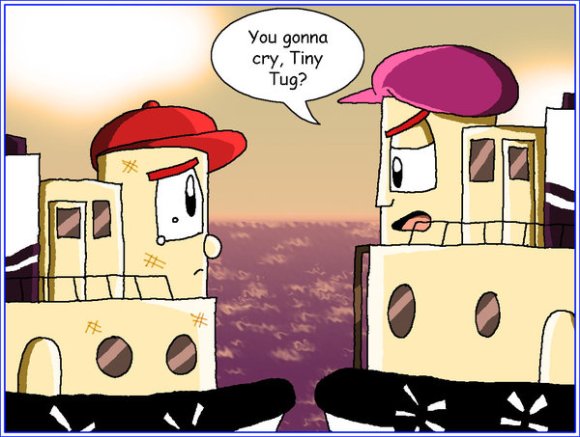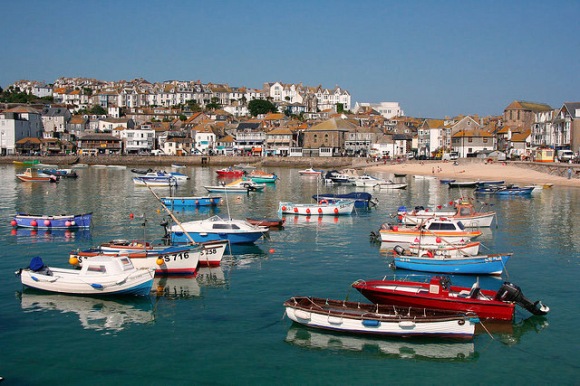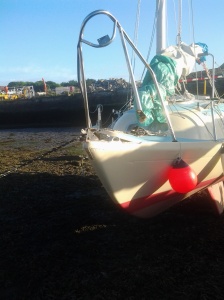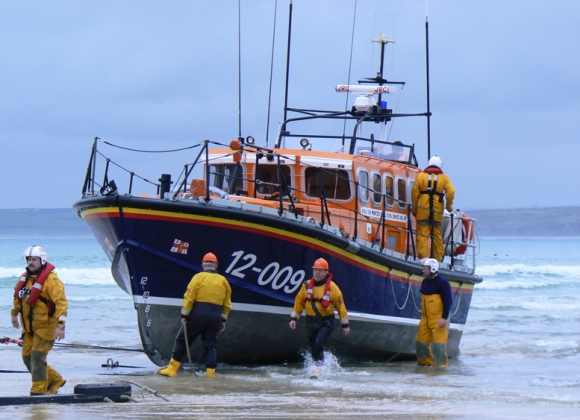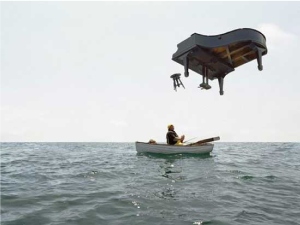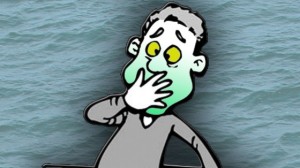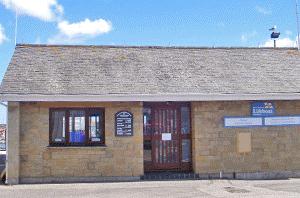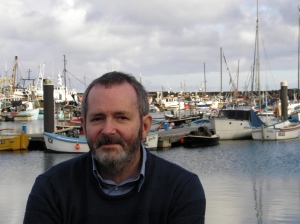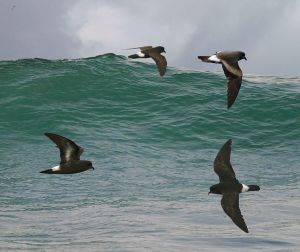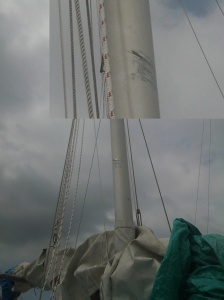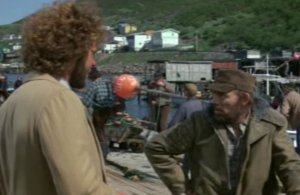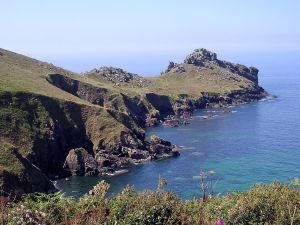This is the second half of the rescue story: the hijack and mugging.
We found ourselves waiting for the arrival of Sennen lifeboat rather than the fishing boat we had intended. Now we were at anchor, I set about tying away the sail and clearing the hatchway. The damaged sail and rigging filled half the cockpit and blocked the entrance to the cabin.
Getting Tony off the boat and into the lifeboat’s RIB was difficult. Tony was weak and unable to stand. The safety cables surrounding the deck were released to make it easier to get him over the side. Removing the safety wires had the effect of covering the deck with loose steel cable just waiting to trip someone up. With some difficulty we helped Tony out of the cabin. One on each arm we guided him into the RIB where he was caught and aided by the others. Rescue completed. I would rest, patch the boat up, and sail round to Hayle.
Attempted Bullying
I thanked the lifeboatman for his help with Tony and said we would now be on my way.
The lifeboatman sat down and asked
“Would you like a tow back to Newlyn.”
“No thanks. It’s not necessary.” I shook my head.
“Where were you going?”
“Hayle but I was going to divert to St Ives to get Tony home.”
“We’ll tow you to St Ives.”
“I don’t need a tow. The problem is resolved. It’s not necessary. I’ll make my own way. Thank you.”
“I don’t think they’ll let you go on by yourself.” The lifeboatman was making it clear he was in now control.
“There is no longer a problem. I don’t need or want a tow. Tony is off the boat.” I wondered who “they” were and what made him think “they” had the authority to make the decision. There was also the need for them to give me a plausible reason.
Apparently, the lifeboatman had taken my giving him “permission to come aboard” to mean he could take over the boat. This is illegal. Presumably this level of arrogance comes from the local culture of the RNLI and how they are trained. They assume that they know better than other sailors and need to take control for the victims own good. It should be obvious that I have no complaint against this individual who seemed to be doing his best to follow inept instructions. The lifeboatman was good at being politely coercive.
The lifeboat had not formally taken control of the boat. His suggestions were clearly declined. Presumably the RNLI realise they have no legal, or moral, right to take charge of a boat without a clear and present danger. Even if they had such rights, they would need to be sure they had the necessary expertise to reduce the risk to people and property. The lifeboatmen could have requested to take charge of Newlyn Maid rather than asking permission to board . Quite frankly, I would have refused. By now, I was of the firm opinion these people were semi-competent at best.
“We try to tow casualties to where they want to go. Would you prefer to be towed to St Ives or Newlyn?” He asked.
This was a clumsy attempt at giving a choice between two options while excluding others. It has a name Morton’s Fork and is a well know trap used by manipulative people. I shook my head at the idea that I would fall for such a clumsy trick. I wondered when I had become a casualty and why this guy thought I needed help. I did not.
“The casualty is off the boat. You are no longer needed.” I responded firmly.
The concept of No-means-No had not reached the lifeboatmen. Nothing I could say had any effect. They were going to give me a tow whatever I said. They had a fall back explanation: “It’s what we do.” This statement actually means nothing other than they repeat an action whether it is right or wrong. But superficially it appears to give them authority. They all seemed to use it. It was repeated when they ran out of explanations. They want to “rescue” your boat. You need to be saved from something, but they cannot tell you what exactly. Perhaps it’s the bogeyman. You have an objection? Forget it. It’s what they do.
Can you imagine a liner, tanker, or other large vessel being towed to port because one of the passengers became seasick and had been taken off the ship? Neither can I. By contrast, it seems that the RNLI often force so-called rescues on small boats. Their sailor victims are wary of being assailed for making a complaint about the rescue services. However, I am not intimidated. Never having liked bullies, I am quite happy to describe the process.
“The boat is at anchor and completely safe. You are no longer needed.” I stated firmly.
“I’ll just raise the anchor to save time when the St Ives lifeboat arrives.” He responded. It was that unsubtle. He seemed to think that his raising the anchor would make the boat unsafe and negate my objection. It did not.
He moved forward to raise the anchor. Notice that he had made the decision to raise the anchor and not asked permission. I suggested that if he really insisted on raising the anchor I should do it. It has a very long chain and there is no winch. It is difficult. I know how to do it. He declined.
The unstated message was he was in charge and would do whatever he wanted. I would not be allowed to do anything despite being skipper and responsible for the boat. There would be no stopping this “rescue” short of physically removing him from the boat.
Stuck
He started to lift the anchor and after a few feet realised the problem. He was stuck. Lifting an anchor on the end of 125 feet of chain was easy for the first few feet but became progressively more difficult, as muscles fatigued. Once again, I offered to do it. He said no. He told me that when the St Ives lifeboat arrived they would help him. However, he was obviously stuck. Realising his predicament he asked would I help him by putting the chain lock on to help hold the position of the anchor.
For the next few minutes I had a stubborn lifeboatman stuck on the bow of the boat. With intermittent rests he managed to pull up the anchor by himself, finishing sometime after the arrival of the St Ives lifeboat. In the first few seconds of his arrival, I watched the replacement lifeboatman from St Ives trip and kick apart the solar power connection, as he went forward to see what was happening with the anchor. The St Ives lifeboat were really good at wrecking boats.
The Tag Team
The RNLI have a reputation as volunteers going to the rescue of sailors whatever the weather. Most people do not realise that all sailors are required to provide assistance to a boat in trouble. If you are sailing in a Force 10 in mid-ocean and you get a Mayday you are expected to respond. If you are the nearest boat you have just “volunteered”, even if this means sailing through a hurricane. The thing that might stop you from responding is that you are trying to save your own boat and cannot risk the rescue. All ocean sailors have an obligation to do what the RNLI claim is their special remit.
Since they have no actual legal authority the RNLI have methods to demand and maintain control. The lifeboatmen played a tag team with the Sennen man leaving only after the St Ives man had boarded the boat. They were leaving no opportunity for me to prevent their “rescue” short of force. Their methods were transparent but justifying them is challenging.
I settled back to watch how the “experts” worked. Perhaps I could learn something. Perhaps we can all learn something from the events that unfolded. There may be some readers who assume that the lifeboatmen had the expertise to assess the situation whereas I was in some way mentally deficient or incapacitated. They were stopping me from endangering myself. Really? Read on.
Swamping The Boat
The St Ives lifeboatmen asked me if there was somewhere to attach the tow rope. I thought this odd as there was a large cleat on the bow used for mooring. It was obviously strong enough for towing the boat. My mistake. Astonishingly, they did not know how to properly tow a small boat.
St Ives lifeboat set off towing Newlyn Maid. The lifeboatman on board the Maid insisted on holding the tiller. I had to sit in the hatchway looking backwards. Something was wrong. They were towing the boat at well above her hull speed. A 20 foot sailing boat has a hull speed of about walking pace. This was at least twice that speed. I tried to rationalise. They must know this is far too fast. They are experienced. It could be that they have an urgent need to get back. Perhaps they had a real emergency somewhere else. Giving the RNLI the benefit of the doubt in such situations is easy.
At this speed the boat was getting swamped. It would take weeks for me to pump out all the water which slowly made its way down to the bilges. The Maid had been through some heavy weather that had ripped away the self-steering and the hatch. Even adding the collision in a gale and the boat had not taken on water like this. She was built for bad weather not being towed at excess speed. Later I would find the St Ives lifeboat has a local reputation for towing too quickly and swamping small boats.
Splashes of cold sea water was occasionally going down the back of my floatation suit. I shrugged uncomfortably. The lifeboatman asked if I were alright. I told him I was and looked at him more closely. He face looked ghostly white and his eyes were red.
“Are you OK? You look like you’re getting seasick.” I asked sympathetically.
“No! I’m alright. Are you?”
The tone indicated that he was put out that I would make such a suggestion to a tough lifeboatman. I was their designated casualty.
“We take Sturgeon for seasickness. It works well.”
He then gave me instruction on how to prevent seasickness and not have problems in the future. I will use this to explain the problem of RNLI staff assuming they were experts and sailors obviously incompetent. A geeky confession. I am a pharmacologist and had discussed preventing seasickness with a senior medical doctor who specialised in marine expeditions, as well as checking independently with a pharmacist who helped local fishermen. Sturgeon is an antihistamine (cinnarizine) and was our second choice because of possible side-effects and interactions. Of course, the RNLI volunteer knew better. Presumably he thought he had superior knowledge because Tony had become sick while he slept and the adhesive on his anti-sickness patch failed. The lifeboatmen know best. Obvious innit?
Taking note of the speed and the apparent sickness of the lifeboatman I wondered if they were playing a practical joke on him.
“Why are they towing so fast. It must be twice the hull speed.”
“It’s what we do.” He said.
“Are you sure they don’t hate you and are just trying to make you sick.” I smiled.
“No.” He didn’t get my poor attempt at a joke and just looked puzzled.
The Motor Shakes Loose
Bang. The motor tilted and jammed solid in the outboard well. Towing us too fast was bound to cause problems before long. I could not get near the engine as it was behind the lifeboatman. He looked down at the motor.
“Didn’t you lock the motor? The motors got a lock on the side to hold it in place.” He said.
“Does it really? Show me.” I asked disbelieving his claim.
He searched for the lever.
“That’s odd.” he said. “I can’t find it. Must be somewhere else.”
In fact, the motor has a kick up mechanism for shallow water. If the propeller hits the bottom the motor tilts to prevent damage. In this case the force of the water from being towed at excess speed had triggered the mechanism. He tried to put the motor vertical again without success. As he moved away, the motor was shaken about and dislodged from its mount. Later I would find the boats substantial engine mount had also been broken. Bang, crash, wallop. The motor was being thrown around the outboard well. More bangs and crashes. He tried to hold it steady or put it back on its mount without success.
I looked at him accusingly and said that there was no need to wreck the boat. She had not done them any harm. At last, he told the lifeboat to slow down a little so he could put the engine back in place. Despite trying, he could not manoeuvre the engine back and said it had jammed in the well. Of course, I was not allowed to reposition the motor and prevent further damage.
“Do you have a rope so I can tie it up?” He asked.
I started down below quickly in the hope of saving the engine. Tony had placed his big floppy green rubber bucket full of sick at the bottom of the steps. In the confined space I stepped onto the side of the bucket and the largest volume of vomit I had ever encountered jetted up straight into my face. I was covered from head to toe in Tony’s vomit. I cursed, found some paracord, and went back on deck.
The lifeboatman tried tying up the motor and failed again. He would hold it a little more steady with his free hand for the rest of the journey. Later it took me just a few seconds to lift, mount, and secure the motor when I was eventually allowed near it.
The lifeboat gradually sped up again to something more than twice the hull speed. The motor was still rattling about but the lifeboatman’s grip damped the movement. At least there was some slight compensation from the increase in speed as the spray was removing Tony’s vomit…
Multiple Collisions
We were towed into St Ives harbour as it was going dark. Now safely back in harbour I thought that wasn’t as bad as expected. I had been suspicious when I realised that it would be the St Ives lifeboat that towed us in. We had lost all trust in them in our earlier encounter. Despite my misgivings, the Maid just suffered some swamping and damage to the motor and engine well. The damage was as unnecessary as the so-called rescue but not a real problem.
Foolishly, I thought I would shortly have my boat back and be away from all this domineering silliness. Then one of them decided to put the Newlyn Maid next to Smeaton’s Pier and it became utterly bizarre. They did several strange things while in the harbour and caused additional damage but I will just cover the main event.
They tied Newlyn Maid very loosely to the side of the Mersey class lifeboat so she could not move away very far, say a 10 foot gap. I sat on the Maid puzzled by what they were doing. Some of their actions were hidden from me behind the collapsed sail while the lifeboat towered above. They appeared to be going to try to position the Maid next to the pier using the lifeboat rather than more sensibly with the RIB. How would they avoid crushing the little boat? Once again, perhaps I should pay attention I might learn something.
Then the lifeboat revved its engine pulled away from Newlyn Maid, until the ropes went taught, and then it turned and smashed into her side. With the first collision they kissed the Maid’s port quarter doing no damage. The little boat rocked and moved away from the impact. What on earth did they think they were doing now?
For the second collision some seconds later the ropes were adjusted and the lifeboat had moved forward a little when it smashed into the little boat. This impact bent a stanchion, a stainless steel bar for the safety railing, and split the deck from the hull with a loud crack as the fibreglass failed. The Maid tilted sideways again forcing me to hold on. I could feel the flexing of the hull and deck. The little boat was breaking up. This was crazy.
Then the ropes were readjusted again. Once again it backed off to the limits of the ropes, engine revving, another crash, another stanchion torn out and the deck hull joint damaged but further forward this time. Poor Newlyn Maid was pushed to the full extent of her restraining ropes. Her movement away from her attacker only acted to help position her for the next crushing blow. There was no way she could avoid the impacts.
The lifeboat moved forward a little more. Same routine. More engine revving, smash, the squeal from the next stanchion and another loud crack as her hull-deck join failed. They must have readjusted the ropes between each of the collisions to move forward to the next section of the poor little boat. Finally they reached the bow. The lifeboat smashed into the bow twice.
Newlyn Maid was only saved from being written off because of the internal strengthening of the hull. We had reinforced the hull behind the forward bulkhead with glassfibre, diolen (similar to kevlar), and carbon fibre, all bonded with epoxy resin. Fortunately, care had been taken in reinforcing the hull-deck join. We had anticipated storms and possibly a collision at sea but not multiple impacts from a mad lifeboat in a harbour. The storms and a collision at sea had done some damage to the boat’s accessories but nothing that could not be sorted out quickly. By contrast, the crazy lifeboat would have completely destroyed Newlyn Maid without this extra reinforcement.
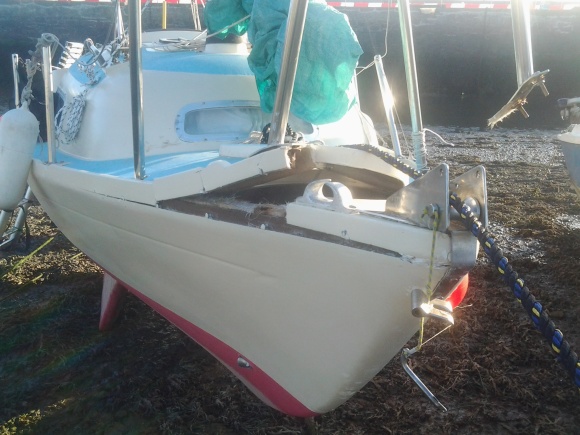
Her Good Side: Separation Of Deck From Hull Forward Of The Reinforcement Notice The Fracture Spreading Back
What did they do it for? Was it a mistake? Incompetence perhaps? We were safe in the harbour. If they insist on making stupid unnecessary rescues they could at least try not to destroy the boat before tying it up.
St Ives has a Mersey class lifeboat which displaces 14 long tons and has an immensely strong aluminium hull designed to resist collisions. It looks like this:
The nearest analogy I have is someone deciding to park a Smart car in a supermarket car park by repeatedly smashing into it with a lorry. It was that stupid.
What were they doing?
We had found the Sennen crew were generally professional if unable to listen or take no for an answer. Tony found them very helpful and supportive. They did their job well right up to the point they insisted on continuing the rescue after the casualty was safe.
The St Ives boat crew were something else. I discussed the St Ives lifeboat’s behaviour and crashing into the Maid with a former member of the Sennen lifeboat crew. He was baffled.
“What did they do that for?” He asked.
“I have no idea.” I replied.
There are three possible explanations:
- The lifeboat could not care less how much damage they caused. This is consistent with their overall attitude. They are “saving lives”. Being allowed a little sarcasm: damage – it’s what they do.
- Just basic incompetence. They did not mean to do it. It was an accident. They did not realise their repeated crashing into the Maid was causing damage despite the screams of bending steel and loud cracking of fracturing fibreglass.
- It was deliberate attempt to sink the boat. They were being vindictive.
None of these possibilities is good. The possibility that the damage was vindictive is hopefully untrue.
Remember the background. Newlyn Maid had been on the front page of the local newspapers as an entrant in the Jester Challenge. The St Ives RIB came out to attempt a “rescue” the day she started sea trials for the Atlantic crossing. This was in St Ives Bay in perfect weather – we were hardly out of the harbour. We were effectively given an ultimatum. We could be rescued with the stated reason being conditions were perfect and there was little wind. (Yes, the idea is insane.) Alternately, they would keep coming out in their RIB shouting at us and being obnoxious as described in an earlier post. We motored around Lands End at night to prevent them hounding us.
That first incident had taken away the opportunity to set the boat up in fine weather. The problems with the boat, such as having to do sea trials in a Force Stupid storm, can be traced back to that initial event; the fruit of a poisoned tree. Now they had got their forced “rescue” and trashed the Maid.
After the Maid’s so-called rescue the St Ives lifeboatmen who seemed to be in charge spoke to me as I was leaving for home.
“Sorry about the damage to your boat”. He was chuffed, full of himself, and grinning from ear to ear. Was it sarcasm? No, it wasn’t sarcasm.
What was that look, that tone? Oh yes, I remember. It’s called gloating.
Update
The RNLI have apologised.
The St Ives Coxswain did not report that he had towed us under protest. Apparently, the correct reporting procedure was not followed. The lifeboat crew has now been briefed to ensure that they understand the need for this to happen.
The former Coxswain claimed that the forced tow and “rescue” had been dealt with locally. It was not. It was an illegal act!
The RNLI have now apologised that Newlyn Maid was damaged and that my experience of the St Ives Lifeboat crew was not a positive one.
They told me that the St Ives lifeboat station has gone through much change including an emphasis on improving the professionalism of the local volunteer team. They are confident that should I interact with them again it would be a more positive experience.
The lifeboat has a new coxswain, following the retirement of the previous holder of the post.
